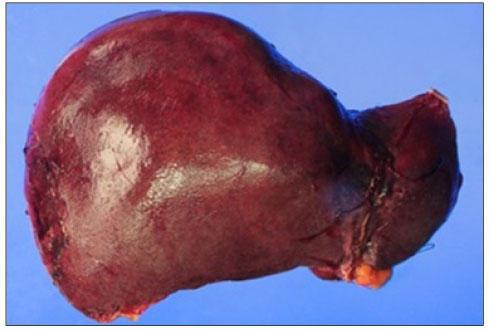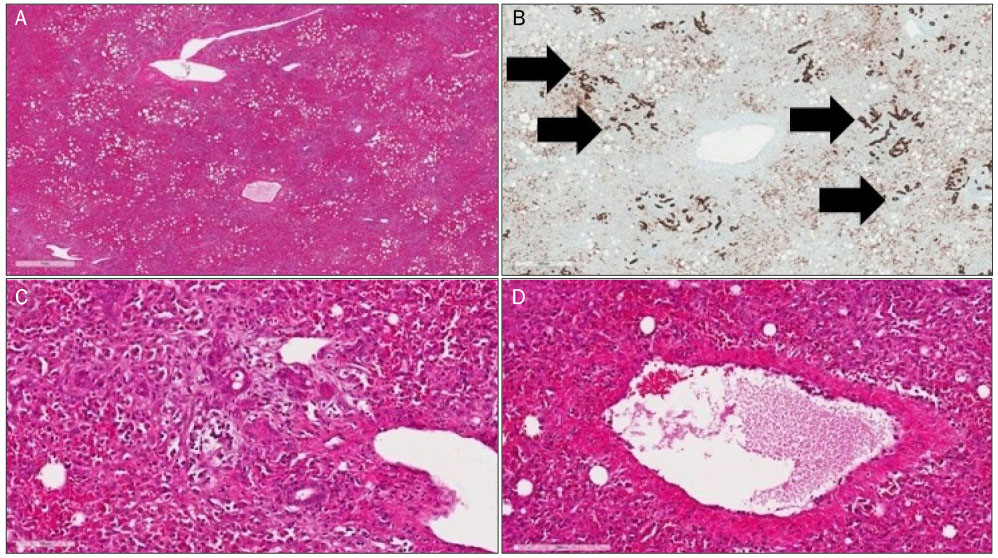Korean J Gastroenterol.
2018 Feb;71(2):94-97. 10.4166/kjg.2018.71.2.94.
Mushroom Poisoning by Macrolepiota neomastoidea
- Affiliations
-
- 1Division of Gastroenterology, Department of Internal Medicine, Dong-A University Hospital, Busan, Korea. p100100@dau.ac.kr
- 2Department of Surgery, Dong-A University Hospital, Busan, Korea.
- 3Department of Pathology, Dong-A University Hospital, Busan, Korea.
- KMID: 2405002
- DOI: http://doi.org/10.4166/kjg.2018.71.2.94
Abstract
- There are currently over 5,000-known species of mushrooms worldwide. Only 20-25% of mushrooms have been named, and 3% of these are poisonous. More than 95% of mushroom poisoning cases occur due to difficulties associated with the identification of mushroom species. Most of the fatal mushroom poisoning cases recorded to date have been related to the Amanita species. Until now, a case of fatal poisoning caused by Macrolepiota neomastoidea (M. neomastoidea) has not been reported in Asia. A 57-year-old male patient was admitted to the emergency room with nausea, vomiting, diarrhea, and abdominal pain. He reported ingesting wild mushrooms with his mother and sister about 2 days ago. His mother and sister were treated with only supportive care, but he was admitted to the intensive care unit and underwent liver transplantation due to acute liver failure. We are reporting a case of fatal M. neomastoidea intoxication from wild mushrooms, a rare case of mushroom poisoning.
Keyword
MeSH Terms
Figure
Reference
-
1. Gonmori K, Yoshioka N. The examination of mushroom poisonings at Akita University. Leg Med (Tokyo). 2003; 5:Suppl 1. S83–S86.
Article2. Yardan T, Baydin A, Eden AO, et al. Wild mushroom poisonings in the Middle Black Sea region in Turkey: analyses of 6 years. Hum Exp Toxicol. 2010; 29:767–771.
Article3. Lin YM, Wang TL. Mushroom poisoning. Ann Disaster Med. 2004; 3:Suppl 1. S8–S11.4. Mottram AR, Lazio MP, Bryant SM. Lepiota subincarnata J.E. Lange induced fulminant hepatic failure presenting with pancreatitis. J Med Toxicol. 2010; 6:155–157.
Article5. Sohn CH. Type and treatment of toxic mushroom poisoning in Korea. J Korean Med Assoc. 2015; 58:818–824.
Article6. Cole FM. Amanita phalloides in Victoria. Med J Aust. 1993; 158:849–850.
Article7. Chan CK, Lam HC, Chiu SW, Tse ML, Lau FL. Mushroom poisoning in Hong Kong: a ten-year review. Hong Kong Med J. 2016; 22:124–130.
Article8. Kim KH, Lee IK, Park KM, Kim WK, Lee KR. Isolation of γ-lactam alkaloids from the Macrolepiota neomastoidea. Bull Korean Chem Soc. 2008; 29:1591–1593.9. Ibáñez-Samaniego L, Bañares R. Acute liver failure caused by mushroom poisoning: still a fork in the road. Liver Int. 2016; 36:952–953.
Article10. Kim KH, Park KM, Choi SU, Lee KR. Macrolepiotin, a new indole alkaloid from Macrolepiota neomastoidea. J Antibiot (Tokyo). 2009; 62:335–338.
Article
- Full Text Links
- Actions
-
Cited
- CITED
-
- Close
- Share
- Similar articles
-
- Type and treatment of toxic mushroom poisoning in Korea
- Severe but reversible acute kidney injury resulting from Amanita punctata poisoning
- A Case of Mushroom Poisoning with Russula subnigricans: Development of Rhabdomyolysis, Acute Kidney Injury, Cardiogenic Shock, and Death
- Death by Hemorrhagic Enteritis due to Suspicious Mushroom Poisoning: A Case Report
- Toxicological Profiles of Poisonous, Edible, and Medicinal Mushrooms




